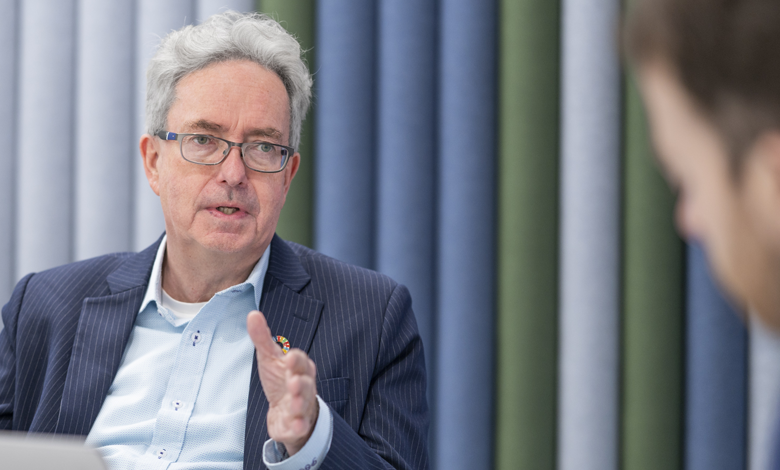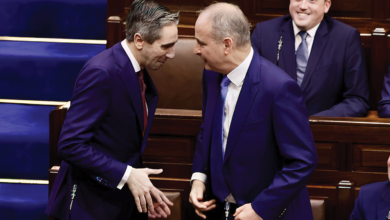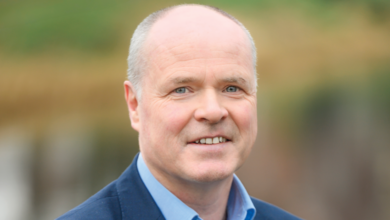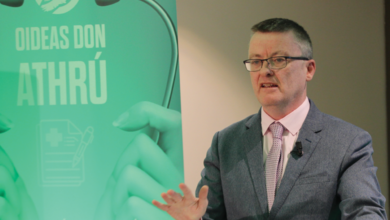25 years of electricity market liberalisation
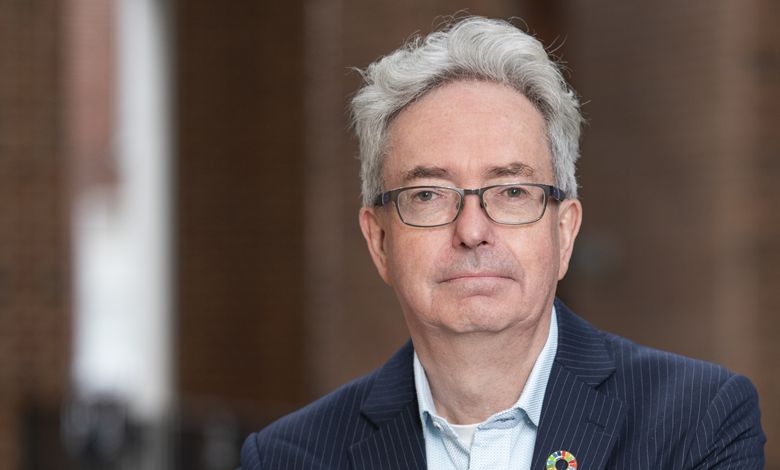
February 2025 marked a quarter of a century since the liberalisation of Ireland’s electricity market. In this context, Ciarán Galway sits down with ESB’s Head of Corporate and Regulatory Affairs, Peter O’Shea, to reflect on how a transformed electricity sector has enabled the transformation of Ireland’s economy in the decades since – while shaping the evolution of green electricity as well as north/south energy collaboration.
Having spent much of the 1990s in Britain working with the National Grid Company, where he experienced firsthand a “decade of excitement around market liberalisation”, O’Shea returned to Ireland and joined ESB in 1999, just as the Irish electricity market was on the cusp of its own liberalisation journey.
“When Britain liberalised its electricity system, the intention was, firstly, to enable competition and give customers choice,” O’Shea says. This was also the motivation behind the European legislation that ushered in the Irish Electricity Regulation Act of 1999 and initial market opening from February 2000. However, the starting point for Ireland was quite different from that of the UK.
Britain was seeking to reduce costs by sweating existing network and generation assets, reflecting the flattening in electricity demand due to energy efficiency and deindustrialisation. In contrast, as Ireland entered the liberalisation era in 2000, the State was on an unprecedented economic growth trajectory.
“In our case, liberalisation was required to set the wheels in motion for major new investment in the generation and network assets needed to meet significantly higher electricity demand throughout the 1990s and into the 2000s, as Ireland’s Celtic Tiger economy grew,” explains O’Shea.
At the same time, it opened the door to new sources of green electricity and greater cross-border collaboration on energy – two developments that resonate particularly in a year which also marks the 10th anniversary of the Paris Climate Agreement and the fifth anniversary of the UK’s formal exit from the EU.
Greater choice for customers
Ireland’s market liberalisation proceeded in stages beginning in February 2000, as the retail and wholesale sectors were gradually restructured to enable competition. The Electricity Regulation Act had established the Commission for Electricity Regulation (CER) to oversee the move to an open market, under the leadership of then-Commissioner Tom Reeves and then-Deputy Commissioner Eugene Coughlan. Among the first hires were Kieran McNamara, now at the International Energy Agency, and Andrew Ebrill, who went on to become Secretary General at the Council of European Energy Regulators and is now at the Department of Transport. They were joined by Cathy Mannion and Denis Cagney as the directors responsible for generation and networks respectively.
Market opening directly involved ESB as the incumbent, with Aidan O’Regan, ESB’s Head of Regulatory Affairs at the forefront of managing the transition. ESB’s Customer Services business unit, encompassing its distribution and retail activities, had to be fundamentally restructured. This led to the establishment of ESB Networks and a separate retail business – initially known as ESB Customer Service, today operating as Electric Ireland.
EirGrid was created as the new electricity Transmission System Operator (TSO), the role previously held by ESB National Grid, and tasked with operation and ensuring the maintenance and development of the transmission network. ESB Networks assumed the role of Distribution System Operator (DSO) and carried out construction and maintenance across both networks.
To kick start the supply market, ESB’s generation business developed and offered a Virtual Independent Power Producer (VIPP) product, to allow electricity suppliers to secure wholesale generation and compete for customers. “In the years that followed, the VIPP concept became a model for other European markets seeking to enable competition,” O’Shea recollects.
Suppliers now began purchasing VIPP and entering the market, providing competitive choice to customers. At the fore of this first wave was Energia, with plans to build a power station at Huntstown, north Dublin.
Initial market opening in 2000 was limited to a small number of large energy users, around 29 per cent of the total customer base by volume. In 2003, the market was opened to all large energy users and other commercial customers. This was followed two years later with full market opening to residential customers, enabled by the Market Opening IT Programme, implemented by ESB with the support of CER – the largest IT programme in Ireland at the time.
Formal regulation of electricity networks begins
In parallel with developments on the retail side, the network activities of ESB and EirGrid became subject to formal economic regulation by CER. Initially CER set allowed revenues and use of system charges for one year, which were then replaced by multiyear Price Reviews.
“2025 will see the establishment of the sixth multi-year Price Review (PR6),” remarks O’Shea, adding: “This formal regulation of networks helped drive efficiencies into operating costs and capital plans, while creating a regulatory model for network investment that enabled long-term planning and secure external funding.”
A competitive generation market
The establishment of the wholesale electricity market – under the governance of CER and operated by EirGrid – was the final step in the initial market liberalisation.
A ‘top-up and spill’ market was put in place, operating in different forms from February 2000 until the establishment of the Single Electricity Market (SEM) in 2007. This intentionally asymmetric market design placed obligations on ESB as the incumbent player, while facilitating the entry of new generation companies to the market. If a new generator produced more electricity than required by their customers, they were entitled to ‘spill’ this to ESB. ESB in turn was obliged to sell top-up electricity to new generators if their supply was insufficient to meet customer demand.
“The wholesale market was developed over the following years by CER through engagement and consultation with all parties. It got an added lift in 2003/2004 when it became clear there was a real possibility for an all-island wholesale electricity market,” O’Shea states.
In 2007, the all-island SEM was established as the trading platform for electricity on the Island of Ireland, providing greater economies of scale than would be available to either market alone. The background was the EU’s 2003 Second Energy Package, which aimed to bridge regional fragmentation by grouping together and encouraging interconnection between neighbouring markets. This could allow electricity generated in one region to be used in another in the absence of barriers, creating price equilibrium and optimising the market.
To give a sense of the scale of change during this period: in 2000, ESB produced 95 per cent of generation output in Ireland. In the liberalised all-island context, this had fallen to 49 per cent by 2015, and to 27 per cent by 2023. ESB’s share of the supply market fell from 100 per cent to 40 per cent in the same period.
Powering a new Ireland
Between 1990 and 2000, amid the first roars of the Celtic Tiger, electricity demand in Ireland grew by 70 per cent and GDP almost doubled. This created a significant need for investment in the electricity network and in generation capacity – and the changes heralded by liberalisation provided fertile ground for this.
“With a regulator in place whose role was to oversee the efficient development of the electricity system, ESB as a commercial semi-state could invest profits and borrowings in energy infrastructure – modernising the State’s electricity network and establishing new generation capacity,” O’Shea points out. The emergence of new generators and suppliers in the market added further to economic development and ensured a competitive, cost-efficient sector.
“These developments taken together were a key enabler of a transformed economy, with new industries and a growing population.”
Ireland’s astonishing growth figures in the 25 years since liberalisation speak for themselves. Between 2000 and 2025, the population has leapt by around 40 per cent, employment has risen from 1.8 to 2.8 million, GDP has quadrupled, and housing units have increased from 1.4 to over 2.1 million. In this same timeframe, electricity demand is up from around 20TWh in 2000 to around 32TWh in 2023, and the number of electricity consumers has grown from 1.6 to 2.4 million.
Over the last quarter century, ESB Networks has invested an increasing amount year-on-year in the electricity network, rising to around €800 million annually and set to grow further. “Around €15 billion has been invested in our networks since 2000, allowing us to keep pace with economic growth, social development, and climate action – and positioning the networks to meet the challenge of decarbonisation and electrification,” says O’Shea.
Cross-border collaboration
Just over a decade after the creation of the all-island SEM, the establishment of I-SEM in 2018 reoriented the focus to the east-west market. As the EU explored further integration of Europe’s electricity systems, Britain and the island of Ireland were regarded as a regional market to be supported with investment in interconnectors, effectively moving towards becoming a single market.
The Moyle Interconnector, commissioned in 2001, was followed by the East-West Interconnector in 2012, bringing physical interconnection of the two electricity systems. Anticipating these developments, British electricity companies had been steadily establishing a presence in Ireland, just as ESB had expanded its footprint in the UK.
However, progress towards full market integration was stymied when Britain opted to leave the EU. 2025 marks the fifth anniversary of the UK’s formal exit. “The strategic thinking previously was that the Irish and British markets would, over time, come together into an integrated market. Brexit disrupted that ambition, and we wait to see if the EU/UK reset discussions in 2025 will reestablish a framework for greater integration,” O’Shea observes.
Yet despite the challenges Brexit has posed, north-south collaboration in the electricity market remains relatively healthy in O’Shea’s view: “Throughout the Brexit discussion, stakeholders from across the island wanted SEM to continue, given the benefits it unlocks.”
Green energy revolution
In addition to marking a quarter century of electricity market liberalisation, 2025 is also the 10th anniversary of COP21 and the signing of the 2015 Paris Climate Agreement. The links between these two developments go beyond the neat timelines, as the story of liberalisation is closely intertwined with Ireland’s journey to green energy in the years since 2000.
As Ireland’s market opened up, new players arrived on the scene, including many renewable generators – chief among them Eirtricity, later renamed SSE Airtricity after its purchase by SSE. The 1999 Electricity Regulation Act gave a boost to ‘green’ electricity suppliers: during the first phase of liberalisation, they were permitted to sell directly to all customers regardless of how much electricity the customer consumed, whereas fossil-fuel-based suppliers could only sell to large energy users.
“Electricity can no longer be seen as a commodity at the point of production.”
Similar to the VIPP process, ESB offered a Green VIPP product to help kick start the supply of green electricity to customers. At the same time, the Irish Government’s Renewable Energy Feed-In Tariff (REFIT) scheme provided financial support and investment certainty to renewable generators, encouraging new development.
Amid this upswing of activity in green generation and the growth of climate consciousness across society, it became clear that the future role of the electricity system would be very different. This was reflected in a shift in ESB’s strategic direction – now seen in its drive to achieve net zero emissions by 2040, as an essential stepping stone to a net-zero Ireland by 2050.
“As we had invested significantly in our networks business to meet electricity demand growth, this provided a platform for further investment to shift the dial towards renewables,” O’Shea comments. Since 2000, ESB Networks has invested a total of around €15 billion in the electricity network, with the aim of delivering the resilient infrastructure needed to support growth and transition to net zero.
The outcome is an energy landscape unrecognisable from that of 25 years ago. From just one wind farm generating 6.5MW in 2000, over 300 wind farms now deliver almost 5GW of electricity to the Irish grid. The system can draw on 1GW of solar power, including from 100,000 microgenerators, and 1GW of battery storage – all non-existent just five years ago.
As for interconnectors, Ireland now has three in place following the recent go-live of Greenlink, a fourth – the Celtic Interconnector – well on the way, and MaresConnect in planning: together, these five will provide almost 3GW of interconnection.
“The electricity system has been and will remain the backbone of decarbonisation, not just delivering green power to customers but also replacing fossil fuels in heat and transport with clean electricity,” says O’Shea. Taken together, electricity generation, heat, and transport account for around two-thirds of Ireland’s carbon emissions.
Discussing the blend of solutions required to deliver 100 per cent renewable energy by 2050, O’Shea acknowledges the role of onshore and offshore wind, solar, long-duration storage, and interconnection. Though he notes that “even massive interconnection will not solve the dunkelflaute challenge” – whereby extended periods of low wind and solar power across Ireland coincide with similar conditions in Great Britain and Europe, reducing availability of renewables and interconnection flows.
One potential solution is green hydrogen: manufactured when wind generation exceeds demand, stored until demand exceeds the renewable output, and then used with fuel cell technology or as a zero-carbon fuel in gas turbines. In 2024, ESB procured hydrogen fuel cells to launch a new hydrogen power demonstration to showcase first deployment of hydrogen to electricity in Ireland.
The evolving role of the electricity market
The imperative to address climate change and the shift to renewables have fundamentally transformed electricity market dynamics. “Paris changed the frame of reference towards net zero and that is now a major driver of the strategies of utility companies, including ESB. Similarly, the CRU’s remit changed to reflect the need for climate action, and decarbonisation is part of its strategy in a way it would not have been previously,” O’Shea observes.
Reflecting on the role of the electricity market in this context, he states: “Back in 2000, the market approach was to optimise price and deliver a secure system. This was challenging in its own right for a small island system, where every increment of additional generation capacity is important to overall system security – a single new entrant generation unit makes up almost 10 per cent of Ireland’s system peak capacity.
“When a third variable relating to climate was introduced, optimisation became more difficult. Markets are great at giving you the right answer where you are minimising or optimising a single variable, but once this becomes more complex or multipolar, their limitations are exposed.”
With the drive to decarbonise accelerating and an increasingly diverse set of assets on the system, a more centralised planning model is emerging – a development reflected in other countries too, most notably Britain. Offshore wind development has shifted to a plan-led approach: the State essentially selects sites for new windfarms, and procurement of capacity and system services have more locational aspects.
“This more centralised approach is to be expected, given the complexity of solving for multiple variables. The key will be to continue harnessing the potential of innovation and market-based solutions, within the more central planned approach,” comments O’Shea. “Realistically, overall market design will need to be looked at again in the coming years – to ensure we can keep delivering the new capacity we need, dispatch it in a way that minimises costs, and send the right signals to customers to unlock the demand side for much more active participation than we see today.”
“One clear consequence is that electricity can no longer be seen as a commodity at the point of production. Today, it makes a real difference whether the electrons have come from a green or brown power source, whether they originate from a flexible or inflexible generator, or whether that generator can demand follow. It is also clear that the cost structure of the generation system is becoming far more fixed, compared to the fixed and variable cost structure of the past. Yet we are using a market model that continues to treat wholesale electricity as a commodity. The next phase of market evolution will address these challenges.”
Future
Given the change that has occurred in the electricity market in 25 years, O’Shea is cognisant that the market may be totally transformed again in the next 25. The single greatest driving force for this change, he reiterates, is the imperative to reach net zero as a country by 2050 – while continuing to sustain a strong and growing economy, as underlined in Mario Draghi’s recent report on EU competitiveness.
“25 years ago, we started a journey to deliver a competitive electricity system focused on customer choice and to ensure sufficient investment in new generation and networks. Thankfully, the journey was flexible enough to allow us to realise that at the halfway mark, the game was changing. It was no longer just about security of supply and cost. It was now about security of supply, cost, and sustainability.”
Reflecting on the previous 25 years and “the huge number of parties involved”, O’Shea concludes: “Many people across government, the CRU, ESB, and other market participants invested a great deal of time and resources in delivering the open and competitive electricity market we have today. The subsequent investment we have witnessed over the last 25 years points to the success of those efforts and while there are challenges with the liberalised market in its current form, its development has positioned Ireland to keep to a net zero future.”

